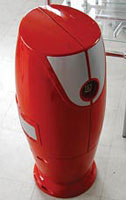Powder Coating: Curing Powder Coating

We coat a variety of parts with different metal gauges from 18-gauge up to very heavy steel plate. Some of our parts that have to be coated include very light gauge stock and very heavy stock in the same assembly. We currently use a waterborne, air-dry liquid paint but we are getting more and more complaints about the durability of the coating. We are interested in powder coating but do not know if we will have problems curing it with all of the different metal masses. Are there cure ovens made for powder coating that can manage these different metal gauges without any problems?
There are many manufacturers of products with a wide range of metal masses within the same assembly that are successfully applying powder coating. Because the heavy gauge parts take much longer to reach the necessary cure temperature range of 375 to 400°F it is usually necessary to use some infrared curing. An infrared cure section at the entrance of the oven can be adjusted to accelerate the cure rate of the heavier metal masses. A convection cure section will finish the cure cycle and provide uniform heating over the entire surface. These systems are often controlled by a PLC to react to the various part configurations automatically. Careful testing is recommended to develop the correct times and infrared design. Some powder coating operations successfully cure products that range from 18-gauge to 4" thick steel plate in the same assembly. Different metal masses and very heavy gauges of steel are commonly powder coated.
There are some plastic materials that can be powder coated. In some cases the plastic powder is melted at 200°F and then cured by ultraviolet (UV) light. However, some composite materials will take the cure temperatures used in more conventional powder cure cycles. The challenge then becomes how to apply a uniform coating with an electrostatic device over a non-conductive surface. In some cases, the plastic surface is cleaned and treated with a conductive material that will provide electrostatic attraction. Application of powder on plastic surfaces is not that common. However, there are several successful operations in North America and Europe. In many cases they are a result of a holistic research process involving the plastic material manufactures and the powder coating material suppliers to develop a complete process. There are a limited number of plastic materials (typically molded composite products) that are suitable for powder application.
Looking for a reprint of this article?
From high-res PDFs to custom plaques, order your copy today!




